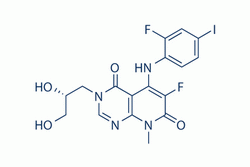| Cas No.: | 1035555-63-5 |
| Chemical Name: | (R)-3-(2,3-dihydroxypropyl)-6-fluoro-5-(2-fluoro-4-iodophenylamino)-8-methylpyrido[2,3-d]pyrimidine-4,7(3H,8H)-dione |
| Synonyms: | TAK733; TAK 733 |
| SMILES: | C1N(C[C@H](O)CO)C(=O)C2C(NC3=CC=C(I)C=C3F)=C(F)C(=O)N(C)C=2N=1 |
| Formula: | C17H15F2In4O4 |
| M.Wt: | 504.23 |
| Sotrage: | 2 years -20°C Powder, 2 weeks 4°C in DMSO, 6 months -80°C in DMSO |
| Description: | TAK-733 is a potent and selective MEK allosteric site inhibitor with an IC50 of 3.2 nM. |
| In Vivo: | The pharmacokinetics of TAK-733 is evaluated in nude mouse, rat, dog and monkey. Low clearance and high oral bioavailability are observed in all species. TAK-733 demonstrates broad antitumor activity in mouse xenograft models of human cancer including models of melanoma, colorectal, NSCLC, pancreatic and breast cancer[1]. Daily oral administration of 1, 3, 10, and 30 mg/kg of TAK-733 for 14 days (Days 10 to 23) results in tumor growth delay in the A375 cell-implanted mice (5/group). TAK-733 (35, 70, 100, and 160 mg/kg) also significantly inhibits tumor growth on an intermittent dosing schedule of 3 days per week for 2 weeks (Days 10, 13, 15, 17, 20, and 22). Three partial regressions (PR), a 60% response rate, are observed in mice administered with 30 mg/kg of TAK-733 daily and in mice administered with 160 mg/kg of TAK-733 intermittently. Responses, CR (complete regression) and partial regressions (PR) are also observed in mice administered with 70, 100, and 160 mg/kg of TAK-733 intermittently. The tumor regression rate is more pronounced with the intermittent administration regimen; the greatest reduction in tumor volume is observed at 160 mg/kg (57.29%), versus a maximum reduction of 46.97% at 30 mg/kg once daily. By the last day of administration, tumor growth is significantly (p<0.05 for %T/C, Student's t-test) inhibited in mice administered 3, 10, and 30 mg/kg once daily or 35, 70, 100, and 160 mg/kg intermittently[2]. |
| In Vitro: | TAK-733 exhibits potent enzymatic and cell activity with an IC50 of 3.2 nM against constitutively active MEK enzyme and an EC50 of 1.9 nM against ERK phosphorylation in cells. TAK-733 does not inhibit any other kinases, receptors or ion channels that are tested with inhibitor concentrations up to 10 μM. TAK-733 is found to bind plasma protein moderately (ca. 97% for human and 96% for mouse), and exhibits high permeability and high microsomal stability across species. It does not inhibit P450s up to 30 μM[1]. TAK-733 demonstrates broad activity in most melanoma cell lines with relative resistance observed at IC50 >0.1 μM in vitro. Thirty-four melanoma cell lines are exposed in vitro to increasing concentrations of TAK-733 for 72 hours. Of the 34 cell lines, 27 are BRAFV600E mutant and 7 are wild-type. SRB proliferation assays are performed and the resulting IC50 concentrations allowed stratification of cell lines into three categories: relatively resistant, intermediate, and highly sensitive. Relatively resistant and highly sensitive lines are assigned based on an IC50 that differ by at least 10 fold[2]. |

 DC Chemicals' products qualify for U.S. tariff exemptions. We guarantee no price increases due to customs duties and maintain stable supply, continuing to deliver reliable research solutions to our American clients.
DC Chemicals' products qualify for U.S. tariff exemptions. We guarantee no price increases due to customs duties and maintain stable supply, continuing to deliver reliable research solutions to our American clients.





















